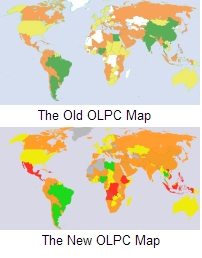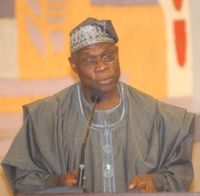It seems wildly optimistic on the part of OLPC to presume that some of these countries, for example Ethiopia and Democatic Republic of Congo (DRC), could be involved at such an early stage, given the political situation they find themselves in. Moreover, the map colouring, in its current form, doesn't reflect facts on the ground:
Thailand is still shown as green - a pilot out country. On September 19th, Thaksin Shinawatra's interim government was overthrown by the military in a coup d'etat. The OLPC project targeted Thaksin's electoral base - the rural poor - at a time when he was campaigning for re-election.
The laptop project is very closely linked to Thaksin - you my remember he frequently announced updates about it to the press. Now that the army is in power, their efforts are likely to be directed elsewhere - ushering in a new government in a year's time. Is a roll out still going to happen there? Probably. Is it going to happen before the elections? Probably not. Things have turned awful quiet regarding OLPC and Thailand of late.
India is listed as a country that has "expressed interest at the Ministry-of-Education level or higher" - that's as well as maybe, but it has been widely reported that India has given OLPC the brush off. At governmental level. For the sake of accuracy, this country should be, at best, yellow or perhaps more accurately, the same grey as North Korea.
Nigeria is talked about as if it is a rock solid roll out candidate and yet the country is heading for an election early in 2007 - at around the time production starts - that promises to be, even to the most rose tinted of views, a fraught affair. According to a recent piece in the Economist, if the elections are successfully completed and a new president takes office:
it will mark the first time peaceful handover from one elected president at the end of his constitutional term to another.Unfortunately, such a turn of affairs seems increasingly unlikely. Earlier this year, President Olusegun Obasanjo's attempts to change the constitution to allow him to stand for a third term in office were defeated. Since then, the political situation in Nigeria has started to hot up somewhat.
Mr Obasanjo has fallen out with his vice president Atiku Abubakar, there have been three political assassinations and 33 of Nigeria's 36 state governors are under investigation for corruption. Moreover, Mr Obasanjo's party, the Peoples Democratic Party (PDP) is starting to split as Mr Obasanjo has yet to anoint a successor.
Perhaps more worrying is this further analysis of the situation by Jibrin Ibrahim, director of the Centre for Democracy and Development (again, from the Economist):
[Jibrin Ibrahim] outlines a scenario in which the poll is so violent and chaotic that Mr Obasanjo will have a pretext for declaring a state of emergency and extending his rule. That would plunge this huge and divided country, with its 250-odd ethnic groups, into a state of virtual civil war. The president's opponents would take up arms and the insurgency in the south would intensify.Looking at two new (and large) red portions of the map, "those countries we plan to include in the post-launch phase", we see two countries that, to my mind, would only be included at this time by the wildest optimists.
Ethiopia is on the brink of all out war with Eritrea (via proxy in Somalia) and Democatic Republic of Congo is still attempting to broker some sort of lasting internal peace after a decade of civil war (which rumbles on in the mineral rich east). If Kabila can legitimise his presidency after the run off on 29th October, then perhaps this will go ahead.
I'm doubtful. I think that Ethiopia and DRC should be coloured differently. However, if they were, that map would look a lot less promising - Ethiopia and DRC add a huge amount of red to it...
So perhaps its time either to take an orange permanent marker to that map, or come up with a more honest colouring system, something along the lines of:
- MOU Signed
- In negotiations
- Approached, Interest.
- Approached, No Interest
- Not Approached




yes its true that pakistan need one laptop per child program.but this is also true we have a system where we divided into educationel systems.one english and other urdu.mostly use urdu.how this program helps those chlidern where you are not using urdu sport softwere.at the end tell me how i can help you and my country childern according to this program.